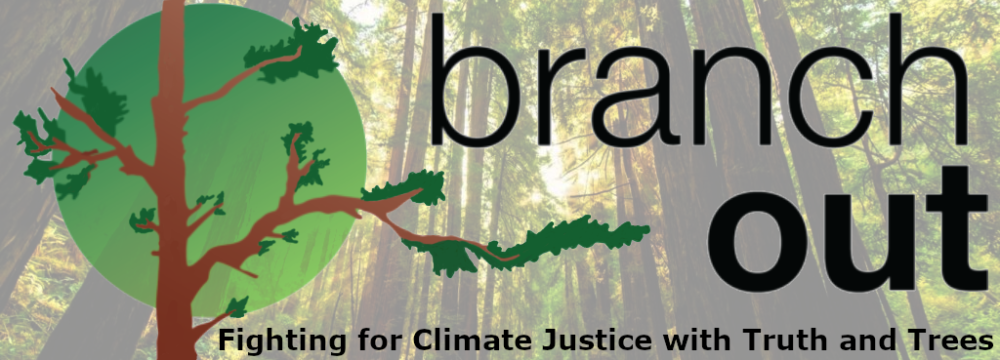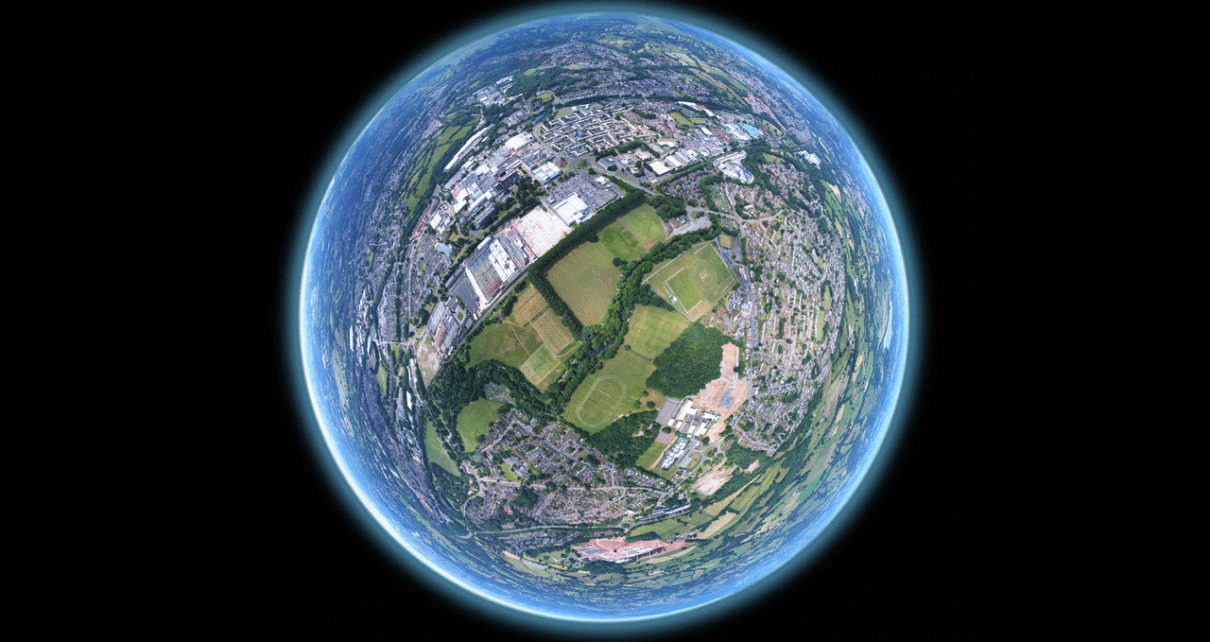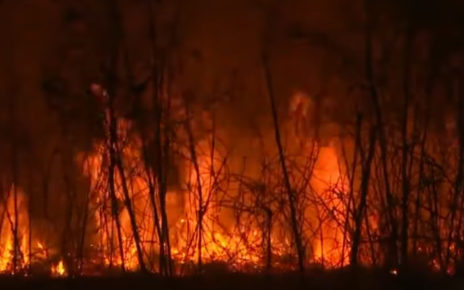It is a bit eerie: Scientific warnings are bypassed for political convenience, misinformation propagates on social media sites to prey upon those susceptible to unprecedented political polarization, and prominent Republican politicians heed upon economic worries to sow doubts that solutions are too expensive or potentially repressive. No, I’m not describing climate change- but the public health crisis brought upon by COVID-19. It seems familiar, right?
Climate scientists have seen this before.
First? Deny the problem. Then, shirk responsibility and continue to downplay the severity of the threat. Finally, recklessly cast solutions as too costly or as too constricting, leading toward a slippery slope of tyranny.
And then, when the real tyranny comes in the form of U.S. police exploiting social distancing guidelines to justify increased brutality against black and brown Americans, many of the same politicians who supported armed anti-lockdown protests have condemned protests in reaction to the police murder of George Floyd.
Originally, it seemed that the coronavirus crisis could have been climate change’s long-lost cousin. The crisis was an imminent catastrophe projecting the country into a bipartisan push for solutions that addressed healthcare and job insecurity while also addressing the underlying racial inequality; challenges that climate scientists have warned must be addressed in order to prepare for the slower moving, seemingly invisible, but more insidious consequences of climate change.
It is upsetting to see how the legacy of climate change denial seeps into the COVID-19 public health crisis to facilitate inaction. But, it is even more upsetting to think about what a failed response to coronavirus means to collective action against climate change.
The History of Climate Science Denialism
The genesis of modern-day climate science denial can ironically be traced back to California. Plagued by unprecedented levels of smog in the 1950s, the city of Los Angeles hired Arie Haagen-Smit, a Cal-Tech biochemist specializing in airborne microscopic chemicals. He quickly determined that the smog was a result of nitrogen oxide emissions and uncombusted hydrocarbons from automobiles and refineries— a finding the American Petroleum Institute (API) found highly disconcerting.
The API and oil industry executives responded with what is now seen as a clear blueprint for science denialism: They hired personal researchers to refute the claims, aiming to split public opinion by introducing alternative evidence and sowing doubt. After about a decade, the results were independently confirmed by additional scientists. API insisted that air quality was a responsibility of the auto industry to regulate tailpipe emissions. Finally, as the establishment of the Environmental Protect Agency and the Clean Air Act of 1970 introduced a new era of environmental regulation, oil companies continued to lobby that federal standards would be too costly, pitting public health against the economy.
Exxon followed suit in the 1980s to deny the impact of carbon dioxide on warming temperatures. After a 1990 report by the Intergovernmental Panel on Climate Change (IPCC) in which the panel reached a “certain conclusion” that unrestrained emissions from fossil fuels would trigger global warming, Exxon’s Chief Scientific Advisor and oil lobbyist Brian Flannery dismissed the consensus by claiming that “the range of models were quite scientifically uncertain,” despite the fact that by the early 1980s Exxon’s own Research and Engineering team had confirmed the climate’s sensitivity to carbon dioxide.
Industry executives seized upon this tactic and successfully created an echo chamber emphasizing small scientific uncertainties until a vicious cycle of misinformation clouded public opinion, despite overwhelming scientific consensus that climate change is real.
The pretense of exploring uncertainty to avoid inconvenient scientific evidence was then heeded upon by Republicans. Despite a 2001 confirmation by the National Academy of Sciences of the IPCC’s assessment of anthropogenic causes of temperature rise linked to the accumulation of greenhouse gases in the atmosphere, the same year President George W. Bush established the U.S. Climate Change Research Initiative to study “areas of uncertainty” in global climate change science.
This instigated a decade of climate denial and debate – primarily by the Republican party – culminating in President Donald Trump’s 2017 decision to leave the Paris Climate Accord.
A Uniquely American Model of Denial
The perceived variability of scientific models has been a favorite scapegoat of climate change deniers.
Speaking to the World Petroleum Congress ahead of 1997 Kyoto Protocol, Exxon CEO Lee Raymond stated “1990’s models were predicting temperature increases of two to five degrees Celsius by the year 2100. Last year’s models say one to three degrees. Where to next year?”
Understanding its effectiveness, many climate change deniers have employed the same tactic to discredit the scientific models from which governments have crafted their coronavirus response.
“It seems like the computer models for the corona virus pandemic are about as accurate as the computer models that have failed so miserably on global warming,” tweeted Patrick Moore, chairman of the CO2 coalition that has actively lobbied the Trump administration to increase its use of fossil fuels. “Proves you can’t predict a chaotic, multi-factor, non-linear future.”
In mid-March, prominent epidemiologist Neil Ferguson and his team at the Imperial College London, an organization widely accepted as the gold standard for infectious disease modeling, released a shocking report. The scientists warned that an uncontrolled spread of the disease could cause as many 2.2 million deaths in the United States and up to 510,000 in the United Kingdom.
The report provoked both the US and UK to quickly strengthen their social distancing measures. Ten days later, however, Dr. Ferguson appeared in front of Parliament and stated that with more stringent social distancing, he now expected the UK’s fatalities to be less than 20,000. (He did not mention any revisions to United States projections).
What happened?
The model had predicted that about a half a million Britons would die without any mitigation efforts. After the report was released, the U.K. swiftly implemented strict social distancing measures, reducing expected deaths.
The model remained constant; the policies were variable. On the other side of the pond, prominent Republicans responded to the apparent about-face with cries for scientific transparency.
“After #COVID-19 crisis passes, could we have a good faith discussion about the uses and abuses of ‘modeling’ to predict the future?” Sen. John Cornyn (R-Texas) tweeted on April 10. “Everything from public health, to economic to climate predictions. It isn’t the scientific method, folks.”
Laura Ingraham, who has used her influence—and lack of a medical degree—to personally lobby President Trump to tout unproven drug treatments, attacked the model on her Fox News show.
“It is worth asking, is it not… would our response have been less damaging to the economy, and to the lives of all of you, millions of Americans, if we had had more accurate models from the start?” Ms. Ingraham questioned.
House Republicans on the Oversight and Reform Committee further echoed the sentiment, requesting an investigation into the models used by the government to craft the coronavirus response.
Led by Representative Chip Roy (R-TX), who has also previously doubted climate science, the Republicans cited concern over the “widely varying revisions” of models, underscoring the importance to ensure “we are not making decisions upon potentially flawed or misrepresentative information.”
Unsurprisingly, despite the number of dead in the United States now reporting more than 100,000 deaths, recent reports have circulated that Trump has privately questioned models.
Models are not crystal balls, and they are not meant to be
Ironically, these criticisms demonstrate an inherent lack of understanding of how scientific modeling works and expose a more sinister attempt to weaponize scientific skepticism.
Scientific models can be simplified into inputs and outputs. Experimental models start with assumptions – inputs – and through complex algorithms based on statistics and mathematics, predict potential results – outputs.
The simplest infectious disease model is the SIR model that identifies the individuals susceptible to the disease, infected with the disease, and recovered from the disease to estimate spread. Comparatively, the most basic climate change models incorporate convection and heat and fluid transfer to estimate temperature rise.
Thus, given an environment with fixed parameters, models are able to predict a mathematical representation of a phenomenon. But now add a key component these simplistic models lack: human behavior.
For example, social distancing could decrease the potential population susceptible to the disease, but how do you make assumptions about a country with 300 million people with 50 different lockdown procedures?
Continue to incorporate variables that drive human behavior –geography, race, and socio-economic class, and it becomes increasingly difficult to make accurate assumptions about human behavior.
This is not to say models are worthless—or should not be considered in policymaking — but to emphasize models are approximations of the system they represent, and thus scientists constantly work to improve and refine them.
Consequently, when these models are plucked from peer-reviewed scientific papers and projected on Fox News, they should not be used as crystal balls to predict the future, but are tools to give policymakers the foresight and agency to avoid worst-case scenarios.
In the fight to delegitimize the call for climate reform, even the Trump administration recognized models’ potential influence in policymaking.
In May 2019, James Reilly, the White-House appointed director of the United States Geological Survey, ordered that all scientific assessments produced by his office may only use models to project the impact of climate change through 2040, even though it is widely accepted that the worst effects will begin to play out in 2050.
Oftentimes, as demonstrated by the Imperial College London model, once projections are made public, the model can inspire immediate changes in human behavior – or implemented policies—that change underlying parameters. As scientists adjust assumptions and incorporate more data, the failure of earlier models depicting dire consequences to come to fruition is not only expected but welcomed.
The Fatal Flaw: Partisan battleground
According to a Pew Research Center poll conducted between March 10 and March 16, 59% of Democrats and Independents who lean Democratic said the outbreak was a major threat to the population’s health, but only 33% of Republicans and Republican-leaning independents responded similarly.
Another NPR/PBS NewsHour/Marist College poll conducted around the same time showed similar astounding partisan divide. While 56% of Americans identified coronavirus as a “real threat,” 70% of Democrats were more likely agree compared to 40% of Republicans.
Recent surveys have shown the partisan gap has persisted: A CNBC/Change Research survey on voters in key 2020 swing states saw that only 39% of Republicans said they had at least somewhat serious concerns about coronavirus compared to 97% of Democrats who said they still had significant worries.
The legacy of Exxon’s successful climate denial blueprint is even more astounding.
Vox’s Patrick Sharkey performed a regression analysis of data from Unacast, a technology company specializing in analysis of “human mobility data” and responses from Yale Climate Change in the American Mind survey, to reveal that one of the strongest indicators of adherence to social distancing guidelines is found in attitudes toward climate change.
The areas where residents are less likely to agree that global warming is happening, that there are anthropogenic causes, and that humans have an obligation to do something about it, are the places where residents have failed to change their behavior in response to coronavirus.
Climate change and the public health crisis imposed by the COVID-19 share some unfortunate similarities. They are both difficult to predict with certainty. Solutions require drastic socioeconomic changes that can upend economies, and the solutions must be implemented before the most dire effects warrant action.
These polls reveal, however, that their key similarity lies deeper than the collective action problem. It lies within the fact that solutions to both crises are contingent upon human behavior that is marred by unprecedented political polarization.
What the similarities expose
Similar to climate change, the public health crisis brought by COVID-19 will not distribute disasters equitably. As demonstrated by how the virus has specifically devastated Black Americans and Native American communities, the most dire effects of the crises will be felt by the most vulnerable – namely poor individuals of color without the agency to demand equality. Earlier this month, the Navajo Nation surpassed New York state for having the highest number of COVID-19 cases per capita within the United States borders.
Solutions that attempt to correct for systematic inequality then trigger worldviews of community dynamics. Whether its aggressive measures to social distance or decarbonize an economy, solutions that challenge traditional racial and socio-economic constitutions cause individuals not immediately suffering under previous structures to become resistant to science. And as we have seen, Americans choose to react to this discomfort by isolating themselves in communities (political parties, Facebook groups, Twitter feeds etc.) increasingly defined by socioeconomic class and political ideology.
All of this is aided by conservative political ideologies that are increasingly inconvenienced by observed scientific fact. Solutions to both crises necessitate potentially chaotic socio-economic disruptions that must be accounted for. But even more, solutions to both crises require a collective action rooted in government leadership—and if voters see that aggressive government intervention can be effective in one area, politicians worry that voters might look more favorably on government intervention in other areas: healthcare, access to education, voting rights.
So sure- the Republican Party and Donald Trump’s reaction to the coronavirus crisis have been riddled with a lack of scientific understanding. But it is not only due to personal inadequacies, but a concerted effort to continue the legacy of climate change denialism.




